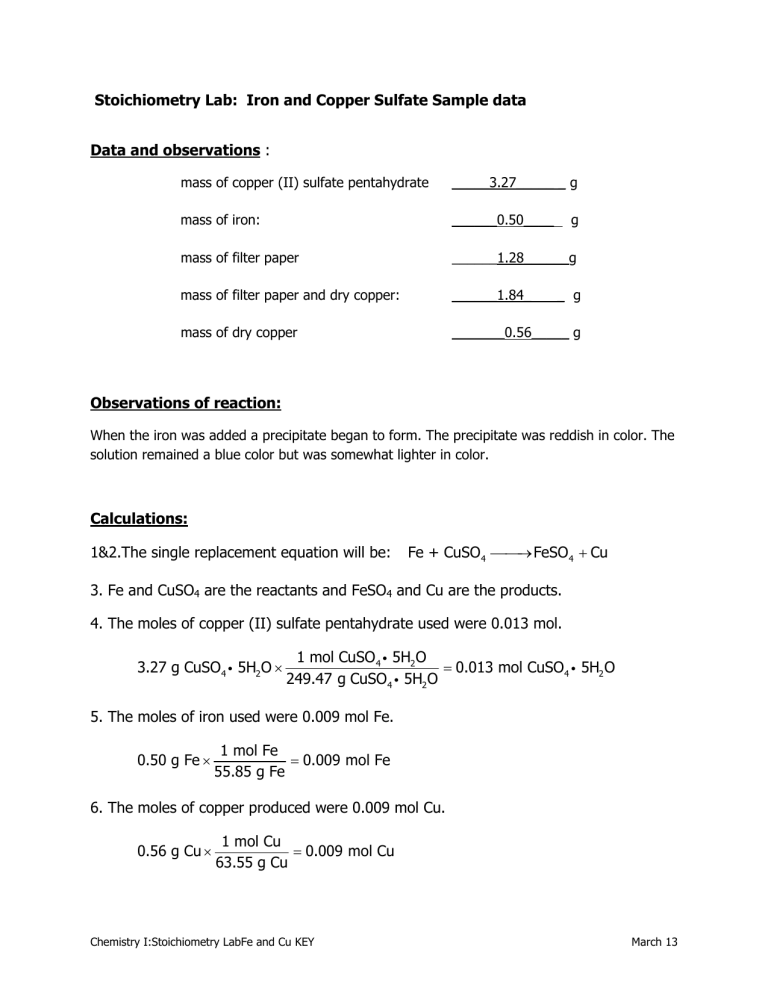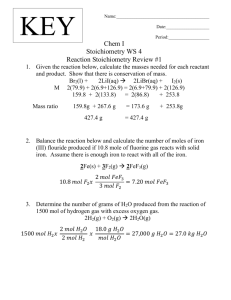Stoichiometry Lab: Iron and Copper Sulfate

Stoichiometry Lab: Iron and Copper Sulfate Sample data
Data and observations : mass of copper (II) sulfate pentahydrate _____3.27_____ _ g of g mass of filter paper mass of filter paper and dry copper: mass of dry copper
______1.28______g
______1.84_ _ g
_______0.56_____ g
Observations of reaction:
When the iron was added a precipitate began to form. The precipitate was reddish in color. The solution remained a blue color but was somewhat lighter in color.
Calculations:
1&2.The single replacement equation will be: Fe + CuSO
4
FeSO
4
Cu
3. Fe and CuSO
4
are the reactants and FeSO
4
and Cu are the products.
4. The moles of copper (II) sulfate pentahydrate used were 0.013 mol.
2
4
4
2
249.47 g CuSO 5H O
5. The moles of iron used were 0.009 mol Fe.
0.50 g Fe
1 mol Fe
55.85 g Fe
0.009 mol Fe
2
6. The moles of copper produced were 0.009 mol Cu.
0.56 g Cu
1 mol Cu
63.55 g Cu
0.009 mol Cu
Chemistry I:Stoichiometry LabFe and Cu KEY March 13
7. The mole ratio will be 1:1.
0.009 mol Fe 1mol Fe
Questions:
1. The ratios are equivalent.
2. The moles of copper (II) sulfate pentahydrate used was 0.0013 mol. The amount needed to complete react with the Fe was 0.009 mol. Therefore, 0.004 mol copper (II) sulfate pentahydrate were left in solution. This was evident by the blue color of the filtrate.
3. Iron was the limiting reagent because it was in lesser amount of the reactants.
4. The calculation for the theoretical yield of copper is:
0.50 g Fe
1 mol Fe
1 mol Cu 63.55 g Cu
55.85 g Fe 1 mol Fe
1 mol Cu
0.57 g Cu
5. Percent yield for this laboratory exercise is 98.2 %.
% Cu yield=
0.56 g Cu
0.57 g Cu
6. A number of sources of error could occur.
1. not allowing the reaction to complete
2. error in recording masses
3. Not recovering all of the Cu from the 100-mL beaker
4. Not drying the filter paper completely
7. (optional)
Since the mole ratio (determined from the balance equation) is 1 mol Cu to 2 mol Ag. So if 3 mol Cu react with an abundant amount of silver nitrate then 6 mol Ag will be produced
Chemistry I:Stoichiometry LabFe and Cu KEY March 13








